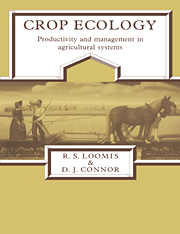Book contents
- Frontmatter
- Contents
- Preface
- Part I Farming systems and their biological components
- Part II Physical and chemical environments
- Part III Production processes
- 8 Nitrogen processes
- 9 Water relations
- 10 Photosynthesis
- 11 Respiration and partitioning
- Part IV Resource management
- References
- Species list
- Conversions and constants useful in crop ecology
- Index
11 - Respiration and partitioning
from Part III - Production processes
Published online by Cambridge University Press: 05 June 2012
- Frontmatter
- Contents
- Preface
- Part I Farming systems and their biological components
- Part II Physical and chemical environments
- Part III Production processes
- 8 Nitrogen processes
- 9 Water relations
- 10 Photosynthesis
- 11 Respiration and partitioning
- Part IV Resource management
- References
- Species list
- Conversions and constants useful in crop ecology
- Index
Summary
INTRODUCTION
The use of new carbon in growth and respiration are critical processes in crop productivity. The term partitioning is used to describe patterns of carbon use. ‘Allocation’ is used in this sense by some authors but it can imply control by a central authority that does not exist in plants. The main features of partitioning are seen in the changing morphology of the plants during a season: in the changing distribution of number, size, and growth of various organs.
Assimilates are also consumed in respiration and that process must also be considered as a component of carbon partitioning. Respiration furnishes energy and reductant for new construction and for the maintenance of existing structures. The portion linked with growth is termed growth respiration, Rg. The magnitude of Rg varies with the chemical nature of the new construction. Maintenance respiration, Rm, also depends on tissue composition and has precedence over growth for assimilate; together Rm and Rg ordinarily consume 0.3 to 0.5 of gross photosynthesis. Respiration and the chemical composition of new biomass, then, are important aspects of carbon partitioning.
The new assimilates from photosynthesis that serve as substrates for growth and respiration are mainly carbohydrates. Sucrose is the principal transport form in crop plants and sucrose and starch are the main storage forms. For simplicity, we will sometimes represent these by glucose. ‘Old’ assimilates, including materials such as starch that accumulated during earlier periods as well as materials mobilized during the senescence of old leaves and other organs, also serve as substrates for respiration and growth.
- Type
- Chapter
- Information
- Crop EcologyProductivity and Management in Agricultural Systems, pp. 289 - 316Publisher: Cambridge University PressPrint publication year: 1992

